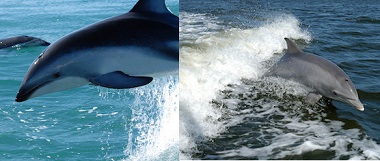450317-dolphin porpoise.jpg

A porpoise on the left and a dolphin on the right. Credit: NOAA, left and NASA, right.
Dolphins and porpoises are among the smartest and most beautiful creatures on the planet. And they’re also among the most popular. Even so, most of us can’t tell dolphins and porpoises apart. Yet there are several key differences, in both appearance and behavior.
Dolphins and porpoises are cetaceans -- a group of animals that also includes whales. There are 32 species of marine dolphins, but only a half-dozen species of porpoises. All of them are warm-blooded mammals that come to the surface to breathe air.
Dolphins are generally longer and sleeker than porpoises. Some dolphin species can grow up to 30 feet long, while porpoises generally don’t get bigger than six or seven feet. Most dolphins have long, slender beaks, with a grin full of sharp, cone-shaped teeth, compared to stubby snouts and flat teeth for porpoises. And a dolphin’s dorsal fin -- the one in the middle of its back -- is generally curved or hook-shaped, compared to a smaller, triangular fin for porpoises.
Dolphins tend to be much more social. They travel in groups and play with passing boats, for example. And, they can communicate by making sounds through their blowholes; the familiar chirping, laughing sounds made by bottlenose dolphins is the best example.
Porpoises and dolphins both face threats from human activities. They get tangled in fishing nets, suffer ill effects from pollution, and face changes in habitat thanks to our changing climate -- making life more difficult for these smart and beautiful creatures.

